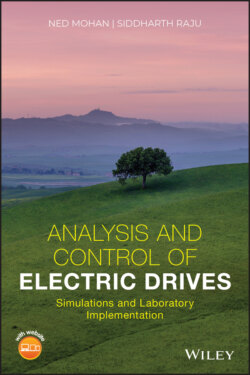Читать книгу Analysis and Control of Electric Drives - Ned Mohan - Страница 48
2‐5 TORSIONAL RESONANCES
ОглавлениеIn Fig. 2-7, the shaft connecting the motor with the load was assumed to be of infinite stiffness, that is, the two were rigidly connected. In reality, any shaft will twist (flex) as it transmits torque from one end to the other. In Fig. 2-11, the torque Tshaft available to be transmitted by the shaft is
(2-31)
This torque at the load‐end overcomes the load torque and accelerates it,
(2-32)
Fig. 2-11 Motor and load‐torque interaction with a rigid coupling.
The twisting or flexing of the shaft, in terms of the angles at the two ends, depends on the shaft torsional or the compliance coefficient K:
(2-33)
where θM and θL are the angular rotations at the two ends of the shaft. If K is infinite, θM = θL. For a shaft of finite compliance, these two angles are not equal, and the shaft acts as a spring. This compliance in the presence of energy stored in the masses, and inertias of the system, can lead to resonance conditions at certain frequencies. This phenomenon is often termed torsional resonance. Such resonances should be avoided or kept low; otherwise they can lead to fatigue and failure of the mechanical components.
